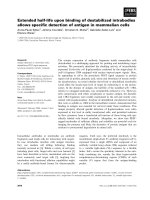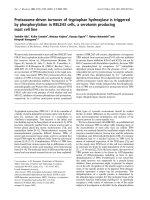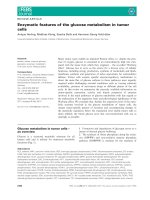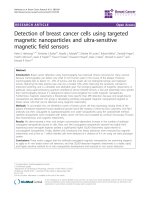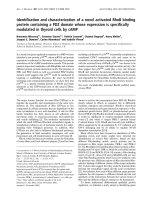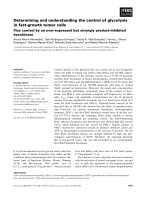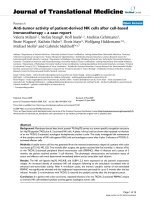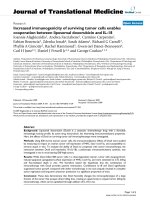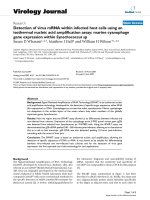Is detection of intraperitoneal exfoliated tumor cells after surgical resection of rectal cancer a prognostic factor of survival
Bạn đang xem bản rút gọn của tài liệu. Xem và tải ngay bản đầy đủ của tài liệu tại đây (849.84 KB, 8 trang )
Arstad et al. BMC Cancer (2017) 17:406
DOI 10.1186/s12885-017-3365-7
RESEARCH ARTICLE
Open Access
Is detection of intraperitoneal exfoliated
tumor cells after surgical resection of rectal
cancer a prognostic factor of survival?
Christian Arstad1* , Paulo Refinetti2, Annette Torgunrud Kristensen1, Karl-Erik Giercksky1 and Per Olaf Ekstrøm1
Abstract
Background: The prognostic significance of free cancer cells detected in peritoneal fluid at the time of rectal
surgery remains unclear. A substantial number of patients will develop metastatic disease even with successful local
treatment. This prospective non-randomized study investigated the prognostic value of intraperitoneal free cancer
cells harvested in peritoneal lavage after surgery for rectal cancer. Mutational hotspots in mitochondrial DNA were
examined as potential molecular signatures to detect circulating intraperitoneal free cancer cells when present in
primary tumor and in lavage.
Methods: Point mutations in mitochondrial DNA amplifications were determined in primary tumors and corresponding
exfoliated intraperitoneal free cancer cells in lavage from 191 patients with locally advanced rectal cancer
scheduled for radical treatment. Mitochondrial DNA target sequences were amplified by polymerase chain
reaction and base substitutions were detected by denaturant, cycling temperature capillary electrophoresis.
Detection of intraperitoneal free cancer cells was correlated to survival.
Results: Of 191patients analyzed, 138 (72%) were identified with somatic mitochondrial point mutations in rectal
cancer tumors. From this fraction, 45 patients (33%) had positive lavage fluid with corresponding somatic mtDNA
point mutations in lavage representing circulating intraperitoneal free cancer cells. There was no significant
survival difference between patients identified with or without somatic mitochondrial DNA point mutations in
the corresponding lavage.
Conclusion: Somatic mitochondrial DNA point mutations identified in primary rectal tumors enable detection
of circulating intraperitoneal free cancer cells in lavage fluid.
Intraperitoneal free cancer cells harvested from lavage immediately after surgery for rectal cancer does not
represent an independent prognostic factor on survival.
Keywords: Rectal cancer, Prognostic factor, Survival, mtDNA mutations
Background
Rectal cancer is frequent in both genders. In 2014 the
incidence in Norway was 1365 new cases in a population
of 5.05 million citizens. [1]. Randomized studies have
demonstrated increased long-term survival in rectal cancer patients receiving chemoradiotherapy in combination with the surgical technique of total mesorectal
excision (TME [2]. A substantial number of patients
* Correspondence:
1
Department of Tumor Biology, Institute for Cancer Research, The Norwegian
Radium Hospital, Oslo, Norway
Full list of author information is available at the end of the article
develops local recurrence and/or metastatic disease despite successful local treatment [3, 4]. Detection of intraperitoneal free cancer cells (IPCC) is considered an
important prognostic tool in ovarian and gastric cancers
[5–11]. In colorectal cancer IPCC with proliferate or
metastatic potential may originate from the primary
tumor and can possibly be detected by peritoneal lavage
[12]. Detection of IPCC during surgery may be of
relevance to improve staging and eventually characterize
patients who may benefit from aggressive multimodal
treatment [12]. However, the clinical significance of
detecting IPCC in colorectal cancer is still debated
© The Author(s). 2017 Open Access This article is distributed under the terms of the Creative Commons Attribution 4.0
International License ( which permits unrestricted use, distribution, and
reproduction in any medium, provided you give appropriate credit to the original author(s) and the source, provide a link to
the Creative Commons license, and indicate if changes were made. The Creative Commons Public Domain Dedication waiver
( applies to the data made available in this article, unless otherwise stated.
Arstad et al. BMC Cancer (2017) 17:406
[12–15]. Different yield rates (2, 2–31%) of positive
IPCC detection reported in colorectal cancer may be
an explanation [12]. Lavage analysis techniques (Cytology,
PCR, Immunocytochemistry) used to identify IPCC vary
with an average of 13%, as calculated from 11 studies involving more than 100 patients, reviewed by Passot et al.
[12]. The use of more sensitive methods to detect IPCC in
studies with a large number of patients could determine if
IPCC is of clinical relevance.
Somatic mitochondrial DNA (mtDNA) mutations are
observed in large fractions of tumors (Manuscript in
press). Utilizing somatic mtDNA mutations in the primary tumor can be used as marker to detect IPCC. The
axiom is that detection of the same mtDNA mutation in
the primary tumor and in the lavage fluid represents
IPCC. This study analyses primary tumors and lavage
from rectal cancer patients only. The aim of this study
was to examine the prognostic impact of IPCC if detected after resection of locally advanced primary or
local recurrent rectal cancer.
Methods
Study population
The Norwegian Radium Hospital is a tertiary referral
center for locally advanced primary and recurrent rectal
cancer. Hundred and ninety-one patients with either locally advanced or local recurrent rectal cancer (TNM
stage II and III) receiving CRT and subsequent surgery
(TME) at the Norwegian Radium Hospital in the period
2000–2006. All patients were of Caucasian origin. Patient’s age ranged from 30 to 87 years with a median age
of 66 (55% men, 45% women). Summary of patient
staging can be found in the supplementary material.
Surgery was performed a median 56 days after completion of radiotherapy.
Follow-up
Initially these patients were included in a pilot study
where KRAS mutations in exon 1 identified in primary
rectal tumors and lavage was reported to be an independent poor prognostic factor for overall survival. [16].
The data is reexamined with extended observation time,
and consequently no censored data. The results debate
previous findings, of which could have been biased by a
large fraction of censored data.
Tumor samples
Rectal tumor tissue samples harvested during surgery
were submerged in an appropriate volume of RNAlater
(Qiagen, Valencia, California, USA) After RNAlater
removal the samples were frozen at −80 °C until DNA
extraction. QIAamp DNA Kit (Qiagen, Valencia, California,
USA) was used for the DNA extraction, following the
manufacturer’s instructions. After resection of the tumor,
Page 2 of 8
the pelvis was washed with sterile water 200–600 ml (discarded) subsequently followed by 200–600 ml saline water.
Two specimens (lavage A and B) of 50 ml lavage fluid were
aspirated to centrifuge tubes. Cells were harvested by centrifugation at 1200G for 10 min followed by removal of the
supernatant. The cell pellets were frozen at −20 °C until
DNA extractions were performed. QIAamp DNA Kit
(Qiagen, Valencia, California, USA) was used for the DNA
extraction, following the manufacturer’s instructions.
First round PCR
Amplification of mtDNA was performed using a two
step nested PCR protocol to avoid amplification of
homologous regions in the nuclear DNA. A set of 5
specific mitochondrial primers were used in the first
round PCR to amplify the base pair regions: 15,924–
201, 16,521–880, 6917–7671, 10,852–11,566, 15,169–
15,993, according to the reference mitochondrial build
NC_012920.1. Primer sequences are displayed in
Table 1. The PCR reaction mixture contained 0.1 μl
of extracted DNA, 0.8 mM dNTPs (0.2 mM of each
dNTP) (VWR, Oslo, Norway), 1X Thermopol Buffer,
2 mM MgSO4, 0.075unit Taq/μl, 0.15 μM of each forward, reverse and fluorescently labeled primer (Integrated DNA Technologies, Leuven, Belgium) and total
reaction volume of 10 μl. The temperature cycling
was performed in a Eppendorf Mastercycler ep gradient S (Eppendorf, Hamburg, Germany) with an initial denaturation 94 °C for 240 s followed by cycling
38 times under the following conditions, denaturation
at 94 °C for 15 s, annealing for 40 s with temperature
given in Table 1 and elongation at 72 °C for 150 s.
Capillary electrophoresis
First round amplification products were verified by capillary electrophoresis in MegaBACE 1000 DNA Analysis
System (GE Healthcare Life Sciences, Pittsburgh, PA,
USA). Samples were loaded into the capillaries from 96well plates by electro kinetic injection at 161 V/cm for
20 s. The temperature of the capillary chamber was set to
27 °C and electrophoresis was carried out at a constant
field of 145 V/cm.
Second round PCR
Templates for second round PCR were 0.8 μl of a 1:200
dilution (first round PCR in H2O). The templates were
dispensed into 96-wells plates with a syringe dispenser
(Hydra 96, Robbins Scientific, USA). To each well 10 μl
reaction mixture was added. The components had a final
concentration; 1xThermopol Reaction Buffer with 2 mM
MgS04, 0.3 μM primers without GC clamp, 0.15 μM 1/
2GC-tailed primer, 0.15 μM, 6-Carboxyfluorescein-GCclamp, 500 μM dNTP, 100 μg Bovine Serum Albumine
(Sigma-Aldrich, Oslo, Norway) and 0.75 U Cloned Pfu
Arstad et al. BMC Cancer (2017) 17:406
Page 3 of 8
Table 1 Primers used in specific mtDNA amplification
#
Start(bp)
End(bp)
Length(bp)
“Forward” primer (5′–3′)
“Reverse” primer (5′–3′)
Annealing
temperature (°C)
23
15,924
201
846
a
AACCGGAGACGAAAACCTTTTTC
a
51
CCATAAAGCCTAAATAGCCCACA
a
54
TGCTCTGAGCCCTAGGATTCATC
a
55.5
51
51
CTTTAGTAGGTATGTTCGCCTGT
1
16,521
880
928
a
10
6917
7671
754
a
GCCTAATTATTAGCATCATCCCC
a
GAGGGGCCACAGTAATTACAAAC
a
16
10,852
11,566
714
a
22
15,169
15,993
824
a
CCAACCCTGGGGTTAGTATAGCT
TGAGGGCGTGATCATGAAAGGTG
ATGCCTCATAGGGATAGTACAAG
TGGGTGCTAATGGTGGAGTTAAA
a
=tail sequence (CGCCCGCCGCGCCCCGCG)
DNA polymerase. Plates were sealed with two strips of
electrical tape (Clas Ohlson, Oslo, Norway). The
temperature cycling was repeated 30 times; 94 °C for
15 s, annealing temperature held for 30 s and extension
at 72 °C for 60 s.
Primer sequences are displayed in Table 2.
was adjusted based on the urea concentration in the
matrix. The cycling temperature was programmed in the
macro. Ini file used by the Instrument Control Manager
(ICM) software package (GE Healthcare Life Sciences,
Pittsburgh, PA, USA). The injection and running electric
fields were as given for the first round amplicons.
Cycling temperature capillary electrophoresis
6-Carboxyfluorescein labeled PCR products were analyzed in a 96-capillary DNA analyzer MegaBACE 1000.
The instrument was modified as previously described to
allow for elevated temperature cycling [17, 18]. The cycling temperature was based on the theoretical melting
temperature, for each fragment, calculated by Poland’s
algorithm in the implementation described by Steger [19].
The separation temperature proposed by the algorithms
Follow up & statistics
Patient’s survival data for 60 months was obtained from
the Norwegian National Health Register. Data analysis
was performed using SPSS 23.0 for Windows (SPSS Inc.
Chicago IL, USA). The log-rank test assessed the differences in survival between groups and cumulative survival
was demonstrated using the Kaplan-Meier plot. P-values
of less than 0,05 were considered statistically significant.
Table 2 Primers used in second round PCR amplification
#
Start
(bp)
End
(bp)
Template, fragment # from # “Forwards” primer (5′ - 3′)
from
“Reverse” primer (5′ - 3′)
1
16,569
25
1
a
AGGATGAGGCAGGAATCAAAGAC 55
CACACTTTAGTAAGTATGTTCGC
55
GGGGTTAGCAGCGGTGTGTGTGTG TCCCACTCCCATACTACTAATCT
55
TGCATGGAGAGCTCCCGTGAGTGG CCCCTTAAATAAGACATCACGAT
2
42
126
1
a
4
131
181
1
a
ATTAACCACTCACGGGAGCTCTC
CACCCTATGTCGCAGTATCTGTC
6
483
513
1
a
7
530
633
1
a
TACCCAGCACACACACACCGCTG
CAAACCTATTTGTTTATGGGGTGA
Annealing
temperature (°C)
52
55
8
673
705
1
a
GGTTTGGTCCTAGCCTTTCTATT
58
82
7031
7134
10
a
AATATGATAGTGAAATGGATTTT
52
84
7340
7416
10
a
TCTCAAATCATGAAAATTATTAAT
125 11,029
11,086
16
a
127 11,193
11,243
16
a
GGTGTTGTGAGTGTAAATTAGT G
55
128 11,283
11,311
16
a
TAATCATATTTTATATCTTCTTC
60
55
60
TTAGAGGGTGAACTCACTGGAAC
ACGACACGTACTACGTTGTAGCC
CTTTCTTCCCACAACACTTT CT C
TTAGGAGGGGGGTTGTTAGGGGGT CATCCCTCTACTATTTTTTAACC
ACCAGCCAGAACGCCTGAACGCA
TGTGCCTGCGTTCAGGCGTTCTGG
55
58
130 11,437
11,492
16
a
176 15,201
15,257
22
a
177 15,274
15,377
22
a
GGTGATTTTATCGGAATGGGAGG
178 15,394
15,448
22
a
TAATGTCATTAAGGAGAGAAGGAA 55
181 15,761
15,864
22
a
CAGGCCCATTTGAGTATTTTGTTT
55
184 16,080
16,130
23
a
ACAGGTGGTCAAGTATTTATGGTA
57
23
a
CCCTATCTGAGGGGGGTCATCCAT 58
187 16,263
a
16,366
TTGACCCAGCGATGGGGGCTTCGA GAGCCAACAACTTAATATGACTA
AGAATCGTGTGAGGGTGGGACTGT AGTAATTACAAACTTACTATCCG
AGTAGACAGTCCCACCCTCACAC
CTAGGAATCACCTCCCATTCCGA
ACCTCCTCATTCTAACCTGAATC
CAAGTATTGACTCACCCATCAAC
AACTGCAACTCCAAAGCCACCCC
=tail sequence (CCCGCCGCCCCCGCCCGGG)
GC-Clamp = (6FAM-GCGCCCGCCGCGCCCCGCGCCCGTCC CGCCGCCCCCGCCCGGG)
60
Arstad et al. BMC Cancer (2017) 17:406
Area under the curves was measured by use of
AcqKnowledge ® 4.4.1 Software & MP150/MP36R in
electropherograms displaying low mutant fractions.
Results
Of 191 locally advanced or local recurrent rectal tumors
72% (138/191) were found positive for at least one
mtDNA mutation. Figure 1 displays two representative
electropherograms of non mutated and mutated samples. Lavage fluids from these 138 patients were subsequently analyzed for corresponding mtDNA mutations.
Forty-five of the lavages were identified with equivalent
mtDNA mutations as in the primary tumor, although in
different fractions. Figure 2 demonstrates mutations in
tumor and in both collections of lavage. Figures 3 and 4
show positive mutant marker only in one of the lavage
samples.
By visual inspection of all lavage electropherograms, the
mitochondrial mutant fraction in the sample was measured. Based on these data lower limit of detection was
calculated to be1%. For survival analysis, a Kaplan-Meier
plot was prepared from patients with locally advanced and
local recurrent rectal-cancer with positive and negative
IPCC in the lavage fluid (Fig. 5).
Observation time was 60 months for all patients. The
log-rank test assessed no significant difference in survival between the positive and negative IPCC for the two
groups (p = 0,716 and p = 0,892).
Initially these patients were included in a pilot study
where KRAS mutations in exon 1 identified in primary
rectal tumors and lavage was reported to be an independent poor prognostic factor for overall survival [16].
Reevaluation of the data with extended time of observation did not validate this assertion. The log-rank test
Page 4 of 8
with uncensored data (60 months) gave no significant
difference (p = 0,177) in survival between positive and
negative KRAS mutations in lavage fluid (Fig. 6). When
comparing the current patient material with the previous
published population [16] no difference in TNM staging
was observed (Additional file).
Discussion
This prospective non-randomized study comprises 191
patients with locally advanced rectal cancer receiving
CRT followed by radical surgery.Local recurrence following CRT and TME cannot be explained only by incomplete surgery, vascular or lymphatic invasion [20]. Pelvic
IPCC with proliferate or metastatic potential may originate from the primary tumor transmitted either prior to
or during surgical procedure and could represent a
source of recurrence. [12]. The survival impact of IPCC
in lavage harvested after surgery for rectal cancer was investigated. The mtDNA of primary rectal tumors were
scanned for mutations. The fragments used are those
covering mtDNA hot spots.The mtDNA hot spots were
determined by CTCE when scanning 76% of the genome
in 94 tumors of different origin (Manuscript in press).
Observing the same mtDNA mutations in primary
tumor and lavage supports the presence of IPCC and
allowed a simplified experimental protocol. The study
population constitutes 138 patients with a positive
mtDNA tumor marker and from these a fraction of 33%
(45/138) was identified with a corresponding marker in
lavage. By detecting the same mtDNA mutation in primary tumor and lavage, was hypothesized to confirm the
existence of IPCC. The lavages from 53 tumors without
mtDNA mutations were not further analyzed. A yield
rate of 33% was considered sufficient to detect a possible
Fig. 1 Electropherogram of primary rectal tumor without mtDNA mutations (top) and primary rectal tumor with mtDNA mutations (lower)
Arstad et al. BMC Cancer (2017) 17:406
Page 5 of 8
Fig. 2 Electropherograms of mutant positive primary rectal tumor with mtDNA mutations and in corresponding lavage A & B
effect on survival [12]. The steps in IPCC detection include collection procedures and sample treatment, cell
separation protocols and chosen biomarkers. Essential to
all these methods is the recognition of markers assumed
to exclusively represent tumor cells and suspending normal tissue in the examined samples. Due to non-specific
labeling, cytology based methods and immunohistochemistry in IPCC detection reports conflicting results
[21–23]. Whole genome sequencing is time-consuming,
expensive, and impractical for routine analysis and is still
left with challenges [24–28]. The combination of a two
staged PCR followed by CTCE represents a quantitative,
fast and inexpensive method with sufficient throughput to detect mutations in human mtDNA [29]. The
standard procedure of peritoneal lavage at the time of
study combines sterilized water followed by saline
water performed after surgery. Assuming that exfoliated
tumor cells will be compromised during exposure to
lavage with sterilized water, the tumor cell viability was
not tested. The lavage fluid includes circulating DNA
generated from bleeding, lymphatic drainage, and tissue
damage during surgery and IPCC if present. The detection limit for the method used is in the order of 1%
[29]. With a detection limit at 1% (sensitivity), the 67%
of lavage fluids without correlating mtDNA mutations,
can be considered IPCC deficient. False negative signals
may occur as a result of lavage contamination with
white blood cells. One ml of blood contains an average
Fig. 3 Electropherograms of primary rectal tumor with mtDNA mutations and mtDNA mutations in lavage A, but not in lavage B
Arstad et al. BMC Cancer (2017) 17:406
Page 6 of 8
Fig. 4 Electropherograms of primary rectal tumor with mtDNA mutations and without mtDNA mutations in lavage A, but with mutation in lavage B
of 5 × 106 white blood cells. Consequently inevitable
surgical bleeding may dilute the IPCC signal below detection limit. The probability of a sub population of
cells to acquire mutations as observed in the primary
tumor is less than 1:1000 (unpublished data), thus justifying the hypothesis that the IPCC signal is derived
from the primary tumor. Observing coexisting mtDNA
mutations in primary tumor and lavage identifies one
tumor lineage. However, all possible tumor lineages are
not necessarily identified. When analyzing tumor and
lavage, four possible analytical outcomes are to be expected. First, detecting positive marker in tumor and
lavage (Figs. 2, 3 and 4). This observation is the only
combination confirming the presence of IPCC. Second
and third, detecting positive marker in tumor or lavage,
while the respectively lavage and tumor are negative for
the marker. These outcomes do not exclude IPCC if
the tumor lineage is devoid of the mtDNA mutation examined or below detection limit of the assay. Fourth,
when tumor and lavage does not contain the marker,
possible IPCC cannot be excluded. Consequently, 75%
of the assay information is non-informative concerning
IPCC status. Hence, a prerequisite for analyzing lavage
samples was positive mtDNA mutations detected in
Fig. 5 Kaplan-Meier plot. Survival analysis, calculated from patients with locally advanced and locally recurrent rectal cancer, having positive IPCC
or negative IPCC. No censored data
Arstad et al. BMC Cancer (2017) 17:406
Page 7 of 8
Conclusion
Mutations in mtDNA can be detected in locally advanced or local recurrent rectal tumors and followed in
exfoliated tumor cells with a detection limit of 1%.
The impact of finding the coexisting mutation in primary tumor and lavage disclosed no prognostic significance on survival.
KRAS mutations identified in locally advanced or local
recurrent rectal tumors and lavage formerly labeled to
be an independent poor prognostic factor on overall survival was not validated.
Abbreviations
CRT: Chemo radiotherapy; CTCE: Cycling temperature capillary electrophoresis;
IPCC: Intraperitoneal free cancer cells; MtDNA: Mitochondrial DNA; PCR: Polymerase
chain reaction; TME: Total mesorectal excision
Funding
This work received financial support from the Torsteds legacy (Oslo, Norway).
Fig. 6 Kaplan-Meier plot. Survival analysis, calculated from patients
with KRAS mutations positive vs. KRAS mutations negative in lavage
fluid. No censored data (P = 0,177)
primary tumors. The frequency of primary rectal tumors with mtDNA mutation in hot-spot fragments was
found to be 72%. From these, 33% had the same
mtDNA mutations in the primary tumor and lavage,
and was interpreted to represent IPCC. The ambition
of pelvic exposure to sterilized water after surgery is to
compromise the viability of possible remnants with
proliferate or metastatic potential. The mtDNA molecular signal does not discriminate IPCC from their
residues. A yield rate of 33% of IPCC detected exceeds
upper limits of previous reports [12]. The survival analysis, comparing patients with positive or negative IPCC
in lavage fluid disclosed no significant difference on
survival (Fig. 5). This is in contrast with former report
on the same patient material using KRAS mutations as
IPCC marker [16]. However, at the time of the previous
study, a large fraction of the population was censored,
as the observation time was not completed. In accordance with the authors of the previous article [16], the
data was re-evaluated, with all patients having their observation period of 60 month complete, and thus no
censored data. This reevaluation did not confirm the
original observation. Detection of KRAS mutation in
lavage fluid have no statistically significant effect on
survival (Fig. 6). This observation is in concordance
with the lead author of the original research article (cowriting this paper) and will be conveyed to the publisher (BMC Cancer).
Availability of data and materials
The data that support the findings of this study are available from the
Norwegian National Health Register but restrictions apply to the availability
of these data, which were used under license for the current study, and
so are not publicly available. The reference mitochondrial sequence
NC_012920.1.were obtained from />NC_012920.1
Data concerning mtDNA mutations analysis and sequencing data are
however available from the authors upon request.
Authors’ contributions
CA performed PCR and CTCE; PR designed the primers, tested the PCR and
optimized the PCR conditions. KEG collected samples, ATK was responsible
for bio banking and DNA extraction. POE participated in the design of the
study. All authors contributed in the writing the manuscript and have read
and approved the final version.
Competing interests
The authors have declared no conflict of interest.
Consent for publication
Not applicable.
Ethics approval and consent to participate
Application (No. 2015/2350) was approved by the Regional Committee for
Medical and Health Ethics of South-East Norway 2016–02-15 and followed
the Declaration of Helsinki guidelines. Written informed consent was
required for participation.
Publisher’s Note
Springer Nature remains neutral with regard to jurisdictional claims in published
maps and institutional affiliations.
Author details
1
Department of Tumor Biology, Institute for Cancer Research, The Norwegian
Radium Hospital, Oslo, Norway. 2Chaire de Statistique Appliques, Section de
Mathematiques, EPFL, Lausanne, Switzerland.
Received: 7 October 2016 Accepted: 17 May 2017
References
1. Cancer in Norway 2014 - Cancer incidence, mortality, survival and
prevalence in Norway. Oslo:Cancer. />globalassets/cancer-in-norway/2014/cin_2014.pdf. Registry of Norway, 2015.
2. Valentini V, Beets-Tan R, Borras JM, Krivokapic Z, Leer JW, Pahlman L, et al.
Evidence and research in rectal cancer. Radiother Oncol. 2008;87(3):449–74.
Arstad et al. BMC Cancer (2017) 17:406
3.
4.
5.
6.
7.
8.
9.
10.
11.
12.
13.
14.
15.
16.
17.
18.
19.
20.
21.
22.
23.
24.
25.
26.
27.
28.
Kusters M, Marijnen CA, van de Velde CJ, Rutten HJ, Lahaye MJ, Kim JH, et
al. Patterns of local recurrence in rectal cancer; a study of the Dutch TME
trial. Eur J Surg Oncol. 2010;36(5):470–6.
Segelman J, Granath F, Holm T, Machado M, Mahteme H, Martling A.
Incidence, prevalence and risk factors for peritoneal carcinomatosis from
colorectal cancer. Br. J. Surg. 2012;99(5):699–705.
Lowe E, McKenna H. Peritoneal washing cytology: a retrospective analysis of
175 gynaecological patients. Aust N Z J Obstet Gynaecol. 1989;29(1):55–61.
Ziselman EM, Harkavy SE, Hogan M, West W, Atkinson B. Peritoneal washing
cytology. Uses and diagnostic criteria in gynecologic neoplasms. Acta Cytol.
1984;28(2):105–10.
Colgan TJ, Boerner SL, Murphy J, Cole DE, Narod S, Rosen B. Peritoneal lavage
cytology: an assessment of its value during prophylactic oophorectomy.
Gynecol Oncol. 2002;85(3):397–403.
Nath J, Moorthy K, Taniere P, Hallissey M, Alderson D. Peritoneal lavage
cytology in patients with oesophagogastric adenocarcinoma. Br. J. Surg.
2008;95(6):721–6.
Iitsuka Y, Shiota S, Matsui T, Murata Y, Kimura A, Koga S. Relationship between
the cytologic characteristics of intraperitoneal free cancer cells and the
prognosis in patients with gastric cancer. Acta Cytol. 1990;34(3):437–42.
Boku T, Nakane Y, Minoura T, Takada H, Yamamura M, Hioki K, et al. Prognostic
significance of serosal invasion and free intraperitoneal cancer cells in gastric
cancer. Br. J. Surg. 1990;77(4):436–9.
Bonenkamp JJ, Songun I, Hermans J, van de Velde CJ. Prognostic value of
positive cytology findings from abdominal washings in patients with gastric
cancer. Br. J. Surg. 1996;83(5):672–4.
Passot G, Mohkam K, Cotte E, Glehen O. Intra-operative peritoneal lavage for
colorectal cancer. World J Gastroenterol. 2014;20(8):1935–9.
Sibio S, Fiorani C, Stolfi C, Divizia A, Pezzuto R, Montagnese F, et al. Detection
methods and clinical significance of free peritoneal tumor cells found during
colorectal cancer surgery. World JGastrointest Surg. 2015;7(9):178–84.
Skipper D, Cooper AJ, Marston JE, Taylor I. Exfoliated cells and in vitro
growth in colorectal cancer. Br. J. Surg. 1987;74(11):1049–52.
Umpleby HC, Fermor B, Symes MO, Williamson RC. Viability of exfoliated
colorectal carcinoma cells. Br J Surg. 1984;71(9):659–63.
Kristensen AT, Wiig JN, Larsen SG, Giercksky KE, Ekstrom PO. Molecular
detection (k-ras) of exfoliated tumour cells in the pelvis is a prognostic
factor after resection of rectal cancer? BMC Cancer. 2008;8:213.
Ekstrom PO, Bjorheim J, Thilly WG. Technology to accelerate pangenomic
scanning for unknown point mutations in exonic sequences: cycling
temperature capillary electrophoresis (CTCE). BMC Genet. 2007;8:54.
Ekstrom PO, Khrapko K, Li-Sucholeiki XC, Hunter IW, Thilly WG. Analysis of
mutational spectra by denaturing capillary electrophoresis. Nat Protoc.
2008;3(7):1153–66.
Steger G. Thermal denaturation of double-stranded nucleic acids: prediction
of temperatures critical for gradient gel electrophoresis and polymerase
chain reaction. Nucleic Acids Res. 1994;22(14):2760–8.
Wu JS, Fazio VW. Management of rectal cancer. J Gastrointest Surg. 2004;8(2):139–49.
Hase K, Ueno H, Kuranaga N, Utsunomiya K, Kanabe S, Mochizuki H.
Intraperitoneal exfoliated cancer cells in patients with colorectal cancer. Dis
Colon Rectum. 1998;41(9):1134–40.
Vogel P, Ruschoff J, Kummel S, Zirngibl H, Hofstadter F, Hohenberger W, Jauch
KW: Prognostic value of microscopic peritoneal dissemination: comparison
between colon and gastric cancer. Dis Colon Rectum 2000, 43(1):92-100.
Kanellos I, Demetriades H, Zintzaras E, Mandrali A, Mantzoros I, Betsis D.
Incidence and prognostic value of positive peritoneal cytology in colorectal
cancer. Dis Colon Rectum. 2003;46(4):535–9.
Salas A, Yao YG, Macaulay V, Vega A, Carracedo A, Bandelt HJ. A critical
reassessment of the role of mitochondria in tumorigenesis. PLoS Med.
2005;2(11):e296.
Roach JC, Glusman G, Smit AF, Huff CD, Hubley R, Shannon PT, et al.
Analysis of genetic inheritance in a family quartet by whole-genome
sequencing. Science (New York, NY). 2010;328(5978):636–9.
Mardis ER. Next-generation DNA sequencing methods. Annu Rev Genomics
Hum Genet. 2008;9:387–402.
Gundry M, Vijg J. Direct mutation analysis by high-throughput sequencing: from
germline to low-abundant, somatic variants. Mutat Res. 2012;729(1–2):1–15.
Wall JD, Tang LF, Zerbe B, Kvale MN, Kwok PY, Schaefer C, et al. Estimating
genotype error rates from high-coverage next-generation sequence data.
Genome Res. 2014;24(11):1734–9.
Page 8 of 8
29. Refinetti P, Morgenthaler S, Ekstrom PO. Cycling temperature capillary
electrophoresis: a quantitative, fast and inexpensive method to detect
mutations in mixed populations of human mitochondrial DNA.
Mitochondrion. 2016;29:65–74.
Submit your next manuscript to BioMed Central
and we will help you at every step:
• We accept pre-submission inquiries
• Our selector tool helps you to find the most relevant journal
• We provide round the clock customer support
• Convenient online submission
• Thorough peer review
• Inclusion in PubMed and all major indexing services
• Maximum visibility for your research
Submit your manuscript at
www.biomedcentral.com/submit
